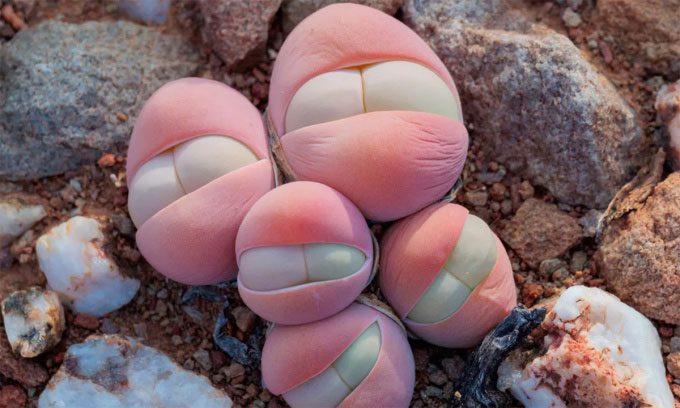The Bababoutjies Succulent: A Unique Plant Native to Klein Karoo
The Bababoutjies, a small succulent species that grows in the vast Klein Karoo valley of South Africa, stands only 6 cm tall but captures attention with its unique shape. The reason this diminutive plant incites laughter is revealed in its name: Bababoutjies – meaning “baby bottom”, as reported by Live Science on August 12.

Bababoutjies is a clustering succulent plant found in South Africa. (Photo: Alamy).
Bababoutjies (Gibbaeum heathii) is a clustering succulent that develops 2 to 3 smooth, round leaves. Older leaves protect the younger ones, growing at the base and covering the plant’s stem. Flowers emerge through the center in late winter to early spring, with colors ranging from white to pink to yellow. The leaves are typically gray-green, but when new growth appears, older leaves can turn pink under certain conditions, making the plant resemble a baby’s bottom even more.
“Many succulent species change color from green to red, which is often a response to stress from water and light. If the plant receives too much light, it will turn red to protect itself from sunburn. Additionally, if deprived of water for an extended period, they may also turn red to cope with the situation,” said Paul Rees, nursery manager at the Royal Botanic Gardens, Kew in London.
The Bababoutjies is endemic to Klein Karoo, located in the Western Cape province of South Africa. Here, they grow among quartzite boulders, a type of stone that reflects heat, creating a cooler environment for them, according to the South African National Biodiversity Institute. Klein Karoo is a valley that stretches 40 to 60 km wide and 350 km long, surrounded by mountains, resulting in very little annual rainfall.
According to the South African Botanical Society, Klein Karoo is part of the Karoo Succulent Biome – one of the richest and most diverse habitats for succulents on the planet. It is estimated that around 3,200 plant species live in Klein Karoo, of which 400 are not found anywhere else in the world.
Many of these species are under threat due to illegal harvesting for the gardening trade, overgrazing by livestock, and climate change. Klein Karoo is expected to face increasingly severe droughts in the coming century. Researchers warn that this could have catastrophic consequences for the flora in this biologically diverse region.


















































